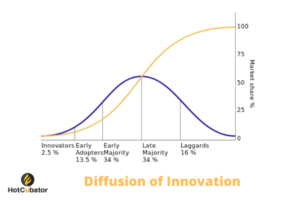
The Innovation virus has continued to plague the world. Whether it is the executive of a fortune 500, entrepreneur of a lean startup, or even a bureaucrat from government department. Everyone eventually comes to a conclusion that “innovation is the only mantra to success”! There is no denying that innovation is essential for success in the cutthroat competitive industry and history is littered with stories about companies which have failed to innovate. But the sad reality is that the “innovation fetish” is doing more harm than good in many occasions. And the superficial usage of the word innovation has transformed the word into a buzzword with no concrete meaning.
To the majority, the meaning of innovation encompasses within flashy gadgets; technologically advanced workplaces; truck loads of budget for a new strategy; or may be running hackathons to attract ideas. Surely, these are part of innovation, but there are other facets as well, which need careful attention and should be instilled within the philosophy of the innovation gurus to avoid the innovation myopia.
From Superficiality to Granularity
The quest of innovation at times becomes so obsessive that people tend to over emphasise external solutions even for simple problems. This happens far from the realisation that often the solution to complex problems lie within the problem itself. Let’s learn from an old but very insightful incident from the 18th century. Puerperal fever aka “Black death of childbed” became widespread in Europe and America in the 18th century. In a desperate attempt to find a cure for this deadly disease, doctors started to probe for a big solution. To find out the causes, the doctors performed autopsy of the corpses of those unfortunate women who died during childbirth. So they would conduct autopsies in the morning and go to the operating room to deliver babies in the afternoon. It wasn’t until the mid-1800s when a renowned doctor named Dr. Oliver Wendell Holmes discovered that the doctors who were conducting autopsies and delivering babies weren’t washing their hands properly. Although this simple discovery initially was ridiculed by all, it was later proved that simply sterilising their hands reduced the percentage of Puerperal fever quite significantly. The lesson learnt from this incident is that breaking a problem to its granular aspects can help to avoid the superficial search for a disruptive solution.
Starting with ‘Why’
Innovation starts with a purpose which is the most important part; yet, this is where majority of the innovation enthusiasts fail to ascertain the actual driver of innovation. Most innovation fans get alluded by the word innovation – driven either by peer pressure or threat from competition or simply to sound very trendy. Although a common consideration is either “we want to disrupt the status-quo” or “we want to think out of the box”, but the market condition may not warrant a new thing. An overly complicated, expensive innovation project might well be sufficed by simple ‘Business As Usual’ activities. Let’s learn from one of the greatest brand blunders – ‘New Coke’ – a product that the consumers never accepted nicely although Coke has remained the all-time global leader of the beverage industry. Threatened by its nearest rival Pepsi, Coke in 1985 decided to change its branding and taste first time in 99 years clearly missing the point that – innovation is not a solution to every problem. It prompted a huge backlash which eventually forced Coke to bring back its own formula. Many years later, Coke appears to be making a similar mistake again with their Coke life. Ask yourself how many times you have purchased a green labelled coke instead of the traditional yet iconic version of Coca-Cola. Lesson from this example is – a change is not always a solution.
Avoiding the Illusion of Ground-breaking Solution
While there is only a fraction of innovations are ground-breaking, most innovations tend to appear exceedingly simple. In other words, thinking simply can also lead to great innovations. Let’s take the example of Apple – undoubtedly, the most innovative brand in the world. But here is an ill-fated story of Apple which is rarely told. ‘Newton’ was an early personal digital assistant, an ancient ancestor of the iOS platform used in the iPhone and the iPad, and the first tablet platform developed by Apple. The Newton’s life span was very short – development started in 1987, product launched in 1993 and cancelled in 1998. So what went wrong? Although Newton was at the forefront of technological advancement during its time of launch, yet it was unable to make its mark for several reasons such as – an overly big screen, too expensive priced most importantly – not understanding what customers really wanted. Apple later realised their mistake and launched the iPhone which is an amazing combination of digital solution including – phone, music player, organizer with a deceptively simple operating system and inspired by Steve Jobs’s dream that ‘consumers would want to lick the screen of iPhone’.
Exploiting Core Competencies
When it comes to digital photography, Kodak’s name will dazzle forever – the brand which invented the first megapixel camera and pioneered the photography industry. Yet, the other aspect of the history is cruel – an epic brand blunder which turned Kodak into one of the greatest case studies of corporate failure. Despite reigning in the industry for decades, Kodak failed to exploit their core competencies. Surely, they were innovative by far any measure compared to its nearest competitors but – they underestimated the ubiquity of photographic industry and overestimated their core competencies. The essence of innovation is knowing the odds and be able to exploit core competencies.
Innovation is All Encompassing
Another common innovation delusion is a unidirectional focus towards new solution. But in reality innovation can only take place when an organisation is able to align its culture, people and process together. No innovation effort can surface in isolation, instead, it is an organisation-wide phenomena that requires optimisation from the – frontline to the boardroom. Probe into the history of the successful brands like Zappos which rose to the peak of success in no time, was only due to combined effort from every aspect including – corporate culture, customer service and staffing.
Image courtesy – Freepik.com
This article was originally contributed by Dr. Sayem Hossain to be published in the Entrepreneur magazine.


